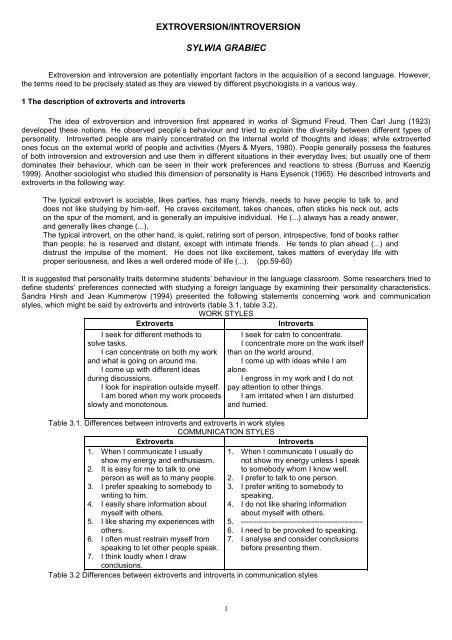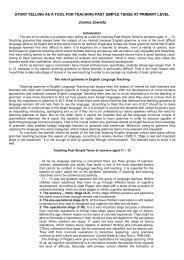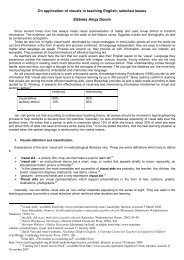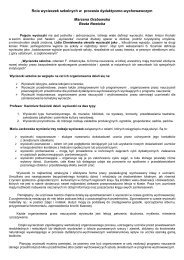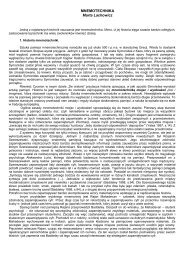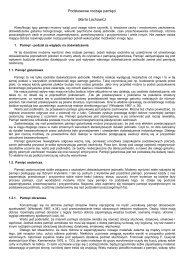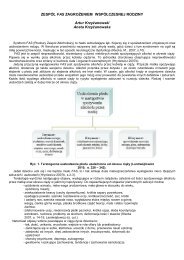EXTROVERSION/INTROVERSION SYLWIA GRABIEC
EXTROVERSION/INTROVERSION SYLWIA GRABIEC
EXTROVERSION/INTROVERSION SYLWIA GRABIEC
You also want an ePaper? Increase the reach of your titles
YUMPU automatically turns print PDFs into web optimized ePapers that Google loves.
<strong>EXTROVERSION</strong>/<strong>INTROVERSION</strong><br />
<strong>SYLWIA</strong> <strong>GRABIEC</strong><br />
Extroversion and introversion are potentially important factors in the acquisition of a second language. However,<br />
the terms need to be precisely stated as they are viewed by different psychologists in a various way.<br />
1 The description of extroverts and introverts<br />
The idea of extroversion and introversion first appeared in works of Sigmund Freud. Then Carl Jung (1923)<br />
developed these notions. He observed people’s behaviour and tried to explain the diversity between different types of<br />
personality. Introverted people are mainly concentrated on the internal world of thoughts and ideas; while extroverted<br />
ones focus on the external world of people and activities (Myers & Myers, 1980). People generally possess the features<br />
of both introversion and extroversion and use them in different situations in their everyday lives; but usually one of them<br />
dominates their behaviour, which can be seen in their work preferences and reactions to stress (Burruss and Kaenzig<br />
1999). Another sociologist who studied this dimension of personality is Hans Eysenck (1965). He described introverts and<br />
extroverts in the following way:<br />
The typical extrovert is sociable, likes parties, has many friends, needs to have people to talk to, and<br />
does not like studying by him-self. He craves excitement, takes chances, often sticks his neck out, acts<br />
on the spur of the moment, and is generally an impulsive individual. He (...) always has a ready answer,<br />
and generally likes change (...).<br />
The typical introvert, on the other hand, is quiet, retiring sort of person, introspective, fond of books rather<br />
than people; he is reserved and distant, except with intimate friends. He tends to plan ahead (...) and<br />
distrust the impulse of the moment. He does not like excitement, takes matters of everyday life with<br />
proper seriousness, and likes a well ordered mode of life (...). (pp.59-60)<br />
It is suggested that personality traits determine students’ behaviour in the language classroom. Some researchers tried to<br />
define students’ preferences connected with studying a foreign language by examining their personality characteristics.<br />
Sandra Hirsh and Jean Kummerow (1994) presented the following statements concerning work and communication<br />
styles, which might be said by extroverts and introverts (table 3.1, table 3.2).<br />
WORK STYLES<br />
Extroverts<br />
Introverts<br />
I seek for different methods to<br />
solve tasks.<br />
I can concentrate on both my work<br />
and what is going on around me.<br />
I come up with different ideas<br />
during discussions.<br />
I look for inspiration outside myself.<br />
I am bored when my work proceeds<br />
slowly and monotonous.<br />
I seek for calm to concentrate.<br />
I concentrate more on the work itself<br />
than on the world around.<br />
I come up with ideas while I am<br />
alone.<br />
I engross in my work and I do not<br />
pay attention to other things.<br />
I am irritated when I am disturbed<br />
and hurried.<br />
Table 3.1. Differences between introverts and extroverts in work styles<br />
COMMUNICATION STYLES<br />
Extroverts<br />
Introverts<br />
1. When I communicate I usually 1. When I communicate I usually do<br />
show my energy and enthusiasm. not show my energy unless I speak<br />
2. It is easy for me to talk to one<br />
to somebody whom I know well.<br />
person as well as to many people. 2. I prefer to talk to one person.<br />
3. I prefer speaking to somebody to 3. I prefer writing to somebody to<br />
writing to him.<br />
speaking.<br />
4. I easily share information about 4. I do not like sharing information<br />
myself with others.<br />
about myself with others.<br />
5. I like sharing my experiences with 5. ------------------------------------------------<br />
others.<br />
6. I need to be provoked to speaking.<br />
6. I often must restrain myself from 7. I analyse and consider conclusions<br />
speaking to let other people speak. before presenting them.<br />
7. I think loudly when I draw<br />
conclusions.<br />
Table 3.2 Differences between extroverts and introverts in communication styles<br />
1
By studying the differences between extroverts and introverts teachers can predict what kind of activities students will<br />
enjoy, what sort of teaching methods they require and what their learning styles are. Burruss and Kaenzig (1999) claim<br />
that extroverts and introverts need different kinds of instruction. Introverts prefer to work on their own than in groups, they<br />
do not like being in the centre of attention and need time and space to complete the tasks. Many of these students enjoy<br />
lectures and deductive methods of teaching. They think carefully before speaking, do not like sharing their inner thoughts<br />
with others unless they know them well and they prefer writing than speaking that makes oral skills more difficult to<br />
acquire. The strategies used in the classroom should include: small group interaction, relaxed atmosphere, independent<br />
studies and role-plays. The students need to know what they are expected to do and have suitable conditions to<br />
concentrate. On the other hand, there are extroverts who require high stimulation, cooperating with others and movement<br />
in order to learn. They also like open discussions and discovery activities. They are not afraid of making mistakes and<br />
experimenting with the language. Their personality traits facilitate the development of general oral communicative<br />
competence, which requires face to face interaction. Teachers should be aware of personality characteristics among<br />
learners and use a great variety if teaching methods in order to achieve the best results (Burruss and Kaenzig 1999).<br />
2 Second language acquisition studies<br />
Ellis (1994) presents two major hypotheses concerning the relationship between extroversion/introversion and L2<br />
learning. The first is that extroverted learners will do better in acquiring basic interpersonal communication skills (BICS).<br />
Extroverts are more eager to talk, to join the groups and participate in classroom activities. They will use the language<br />
more in and outside the classroom. The second hypothesis is that introverted learners will do better at developing<br />
cognitive academic language ability (CALP). Entwistle and Wilson (1977) claim that introverts will achieve more because<br />
they have better long-term memory than extroverts. Besides, they take learning a language in a more serious way and<br />
spend more time on reading and writing due to their personality traits. The extroverts are not able to concentrate for a<br />
long time and are too sociable to learn with the same attention (Eysenck 1957).<br />
Many investigators tried to support these hypotheses with research. Skehan (1989) makes a review of the actual<br />
research results in order to find the relationship between the theory and practice. He notices that some researchers did<br />
not obtain any positive correlations between extroversion/sociability and language achievement, (for example: Smart at<br />
al. 1970; Genessee and Hamayan 1980). On the other hand, Strong (1983) showed that extroversion was an advantage<br />
as far as communication skills are concerned.<br />
A positive relationship between extroversion and oral fluency was also found by Rossier (1976) and Pritchard<br />
(1952).<br />
Skehan (1989) also presents an amended version of the table grouping the studies of extroversion, which was<br />
provided by Strong (1983):<br />
Table 2.3. Second language acquisition studies divided according to type of language sampled and presence<br />
or absence of relationship with social traits.<br />
Positive relationship<br />
Non-relationship<br />
Pritchard (1952) SSC FL Genesse (1980) YC FL Quest<br />
Obser<br />
Rossier (1976) A Nat ?<br />
Suter (1977)<br />
Ely (1986)<br />
A<br />
A<br />
Nat<br />
FL<br />
Quest<br />
Quest<br />
NCL Wong-Fillmore (1976) C Nat Obser Strong (1983) YC Nat Quest<br />
Strong (1978) YC Nat ?<br />
Strong (1983) C Nat Obser<br />
Morrison (1961) A FL ?<br />
LTL Chastian (1975) A FL Obser<br />
Rossier (1976) A Nat ?<br />
Smart (1970) A FL Quest<br />
Swain (1976) YC FL Rating<br />
Chastian (1975) A FL Quest<br />
NCL= Natural communicative language LTL = Linguistic task language<br />
SSC = Secondary School Children YC = Young children A = Adults<br />
? = Value not known Quest = Questionnaire<br />
The results presented in the table above show that positive relationships between extroversion and performance<br />
can be observed when the studies are conducted in naturalistic learning situations and when they measure natural<br />
communicative language. It could be also noticed that every study based on observations provides a positive relationship<br />
(Skehan 1989).<br />
Brown (1994:147) claims that “extroversion may be a factor in the development of general oral communicative<br />
competence, which require face to face interaction, but not in listening, reading and writing.”<br />
Personality characteristics are strongly related to other variables of the learners. Wankowski (1973) studied the<br />
relation between extroversion/introversion and age. He observed that extroverts do better in a primary school, however,<br />
the situation changes at higher education where introverts are more successful. This fact can be connected with the<br />
instruction learners are usually provided at different levels of education. Methods used with younger learners follow<br />
preferences of extroverts, whereas the tasks applied for teenagers and adults are more suitable for introverts (Skehan<br />
1989).<br />
Larsen-Freeman and Long (1991) attempt to find explanations why there is so much diversity among research<br />
results connected with studying personality and language achievement. The first reason for that can be the difficulty in<br />
measuring personality traits. If the tests used are not valid the research will give false results. The second issue worth<br />
2
discussing is that every study investigates different areas of the language so it does not show the overall proficiency of a<br />
student. It is also important to remember that different cultures have different standards of behaviour that are accepted in<br />
a given society. The way students are expected to perform in a classroom definitely affects second language learning, for<br />
example in Japan introversion is valued, while in USA extroverts are favoured. This is strongly connected with the type of<br />
instruction learners are exposed to during the lesson. While introverted learners prefer teacher-oriented methods, they<br />
can not benefit from the lessons that are conducted against their learning styles. Similarly extroverts can not use their<br />
abilities during the lessons that do not give them opportunities to work according to their preferences. The success of<br />
learners is determined by the methods teachers use in the classroom (Fillmore 1982). The conclusion is that the research<br />
studying the relationship between personality traits and SLA should measure students’ proficiency under various types of<br />
instruction in order to obtain relevant results. It is also suggested that personality characteristics may influence second<br />
language learning indirectly. “It may not in itself lead to SL proficiency but it may encourage people to continue with their<br />
study, which in turn promote SLA” (Larsen-Freeman and Long 1991:186).<br />
To sum up, there is some support that extroversion can help in acquisition of BICS, but there is no clear evidence<br />
linking introversion and the acquisition of CALP. Furthermore, “the effects of extroversion/introversion may be situation<br />
dependent, evident in some learning contexts but not in the others” (Ellis 1994:521).<br />
Skehan (1989) notices that process of SLA is a complex one and that both extroversion and introversion have<br />
positive features so it can not be stated that one is more beneficial than the other. It seems that in the best situation are<br />
ambiverts who fall more or less in the middle and reveal preferences of both groups. They adjust easily to new situations<br />
which enable them to meet different learning demands as learning and the use of language involve so many different<br />
skills.<br />
REFERENCES<br />
Brown, H.D. 1994. Principles of Language Learning and Teaching. Englewood Cliffs, N.J.: Prentice Hall.<br />
Burruss, J.D. and L. Kaenzig. 1999. “Introversion: The Often Forgotten Factor Impacting the Gifted”.<br />
(http://cfge.wm.edu/documents/Introversion.html) 2006-03-11<br />
Ellis, R. 1994. The Study of Second Language Acquisition. Oxford: Oxford University Press.<br />
Entwistle, N.J. and J.D. Wilson. 1977. Degrees of Excellence: The Academic Achievement Game. London: Hodder & Stoughton.<br />
Eysenck, H.J. 1957. Dynamics of Anxiety and Hysteria. London: Routledge & Kegan Paul.<br />
Eysenck, H.J. 1965. Fact and Fiction in Psychology. Harmondsworth: Penguin.<br />
Fillmore, W. 1982. “Instructional language as linguistic input: second language learning in classrooms” in L. Wilkinson (ed.),<br />
Communicating in the Classroom. New York: Academic Press.<br />
Hirsh, S. and J. Kummerow. 1994. Life Types. New York: Warner Books.<br />
Jung, C.G. 1923. Psychological types. New York: Harcourt Brace.<br />
Larsen-Freeman, D. and H. M. Long. 1991. An Introduction to Second Language Acquisition Research. New York: Longman.<br />
Myers, I.B. and P.B. Myers, 1980. Gifts differing. Palo Alto, CA: Consulting Psychologists Press.<br />
Prichard, D.F. 1952. ”An investigation into the relationship of personality traits and ability in modern language”. British Journal of<br />
Educational Psychology 22:157-8.<br />
Skehan, P. 1989. Individual Differences in Second-Language Learning. London: Edward Arnold.<br />
3


